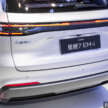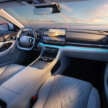Weeks after Geely confirmed the Starray EM-i global name for the Galaxy Starship 7, the plug-in hybrid SUV has now made its ASEAN debut – in right-hand-drive form, no less – at the Gaikindo Indonesia International Auto Show (GIIAS). Bearing absolutely no relation to the regular Starray, the car is set to arrive in Malaysia as the Proton eMas 7 PHEV, the trademark for the latter having already been filed.
Like the pure electric Geely EX5/Proton eMas 7, the Starray EM-i is based on the Global Intelligent New Energy Architecture (GEA), but with Geely’s EM-i (now standing for E-Motive Intelligence) Super Hybrid powertrain. Specs for the Australian market reveal a 1.5 litre BHE15PFI naturally-aspirated four-cylinder engine that produces 99 PS and 125 Nm of torque, which is way down on what the Chinese-market car makes (111 PS and 136 Nm).
Mated to it is an 11-to-1 electrified dedicated hybrid transmission (E-DHT) that combines the P1 integrated starter-generator and P3 drive motor, the latter producing 218 PS (160 kW) and 262 Nm. Total output is rated at 262 PS, all sent to the front wheels.
The P3 motor uses silicon carbide technology to optimise temperature management and ensure peak power no matter the battery charge, Geely claims. Even with the battery charge low, the Starray EM-i’s fuel consumption is said to still be as low as 6.2 litres per 100 km.
Aside from the detuned engine, the global Starray EM-i also receives a smaller 18.4 kWh lithium iron phosphate (LFP) battery, compared to the 19.09 kWh pack in the Starship 7 that delivers an all-electric range of 120 km on China’s lenient CLTC cycle. As such, expect the car’s WLTP-rated range to be just under 100 km. A 3.3 kWh vehicle-to-load (V2L) function is also set to be offered.
Geely says the EM-i system has been developed to offer more cost-effective driving through longer range and low fuel consumption. Three drive modes are available – Pure for sole electric driving, Hybrid that switches between electricity and petrol to optimise range and efficiency, and Power that combined both power sources for maximum performance.
While the Starray EM-i looks identical to the Starship 7 on the outside – full-width front and rear light bars, split headlights, conventional pull-type door handles – the interior is almost completely different. That’s because the cabin has been lifted pretty much wholesale from the EX5/eMas 7, ditching China’s full-width air vent design for the EV’s “wraparound” centre console.
This also means you get all the hallmarks of the twins, including a slimline 10.2-inch instrument display, a 15.4-inch infotainment touchscreen, a row of physical controls and a large multifunction knob below the centre air vents, lidded cupholders arrange diagonally on the centre console and twin smartphone holders (with a Qi wireless charger on the driver’s side) ahead of the armrest.
The carryover interior simplifies the right-hand-drive conversion and makes it easier for factories already building the EX5/eMas 7 to produce it. That’s just as well, because Proton’s Tanjung Malim plant is already being tooled up to churn out the eMas 7 by the end of the year, so it can bring on the PHEV version in double-quick time. Still, with the carmaker already having a lot on its plate this year – including the facelifted X50 set to be launched later today and the forthcoming Saga MC3 – expect to see the car next year instead.






































































































